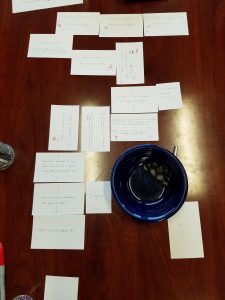Home Front: Week Ten
This week, we presented for Halves.
The team took Halves presentation very seriously. In addition to being part of our grade for the semester, Halves are also our first chance to show off our project to the world outside our client and team. We understood that we needed make our first impression a good one.
Beginning on Monday, we took the base information we had gathered and started trying to make a coherent presentation out of it. Working as a team, we were able to construct a proper narrative about our design process to this point. By Tuesday, we were ready to present to our faculty advisers, and get their feedback. Our biggest note was that we needed to show our work more. They meant both that we had to show the work we had accomplished more, as well as making it transparent as to how we had arrived at this stage in our design. It was a necessary but strange note to be told that we needed to brag about how unique and ground breaking our work is; after ten weeks of being inside of the project, it’s easy to forget that the things we’re doing every day really do make our work special.
To accommodate for the seventeen projects at the ETC this semester, presentations were split up over three days; Monday, Wednesday, and Friday. Home Front was scheduled to present on present on Friday. While we understood that more time for our presentation meant higher expectations, we also took advantage of being able to watch ten other teams present. By observing what worked and what was less successful in the other presentations, we were able to create goals to iterate towards.
Even with our focus being on Halves, the team didn’t sit idle with the design this week. In preparing for our presentation, it became clear that we would need to plainly articulate a sample round of play. This documentation had not been formalized; because we were iterating gameplay in fairly substantial ways between our last version and the current draft, most of our mechanical instructions for the game were still being given orally. Using Halves as our catalyst, the team produced a formal Use Case of our game, and created a recorded demo to be used as part of our presentation.
This week, Qiqi was also able to finalize a second version of the game art, which was approved by our client. With this version of the art, and the recorded play demo, we now had our most current design available to use for our presentation.
By Friday morning, we had incorporated our instructors notes, formalized our presentation, and practiced enough to feel comfortable speaking in front of our classmates and professors. It was time to present. Our slot was the last for the day, making us the 17th and final project to present this week.
For the record, it went quite well.
We’ll be getting formal feedback next week, and will continue onward with design. New priorities are to build a prototype of the game board, further test our current iteration of mechanics, and refine content as we move forward.

